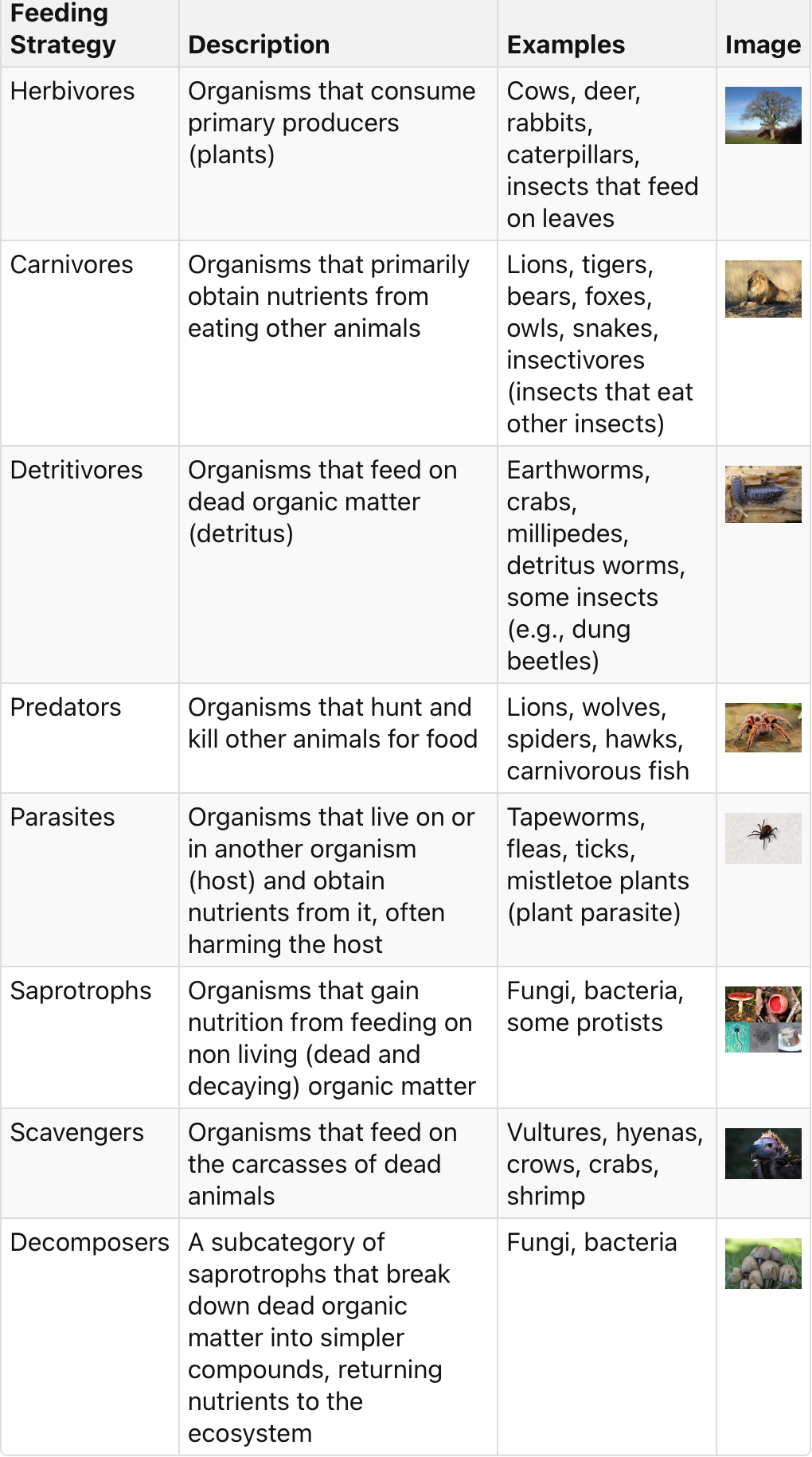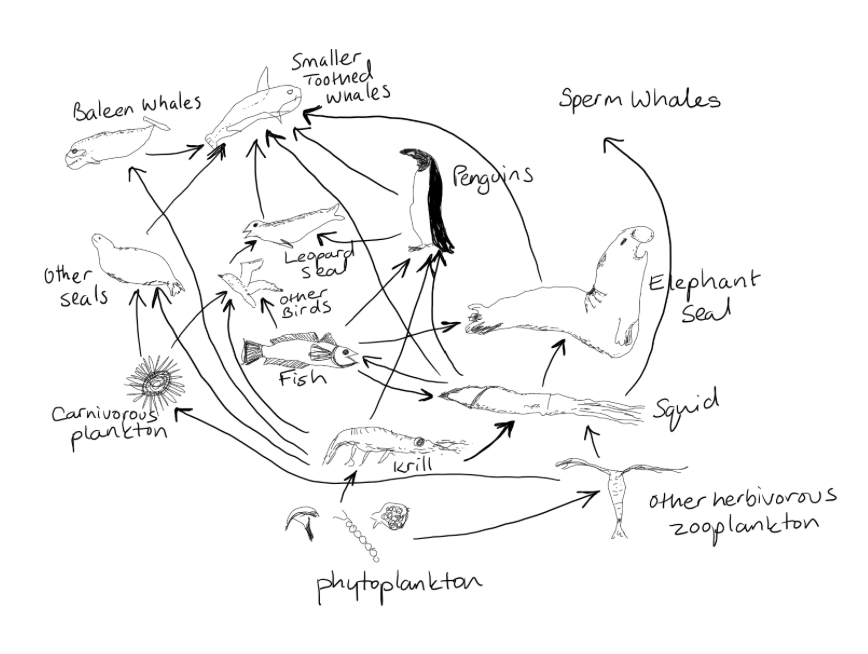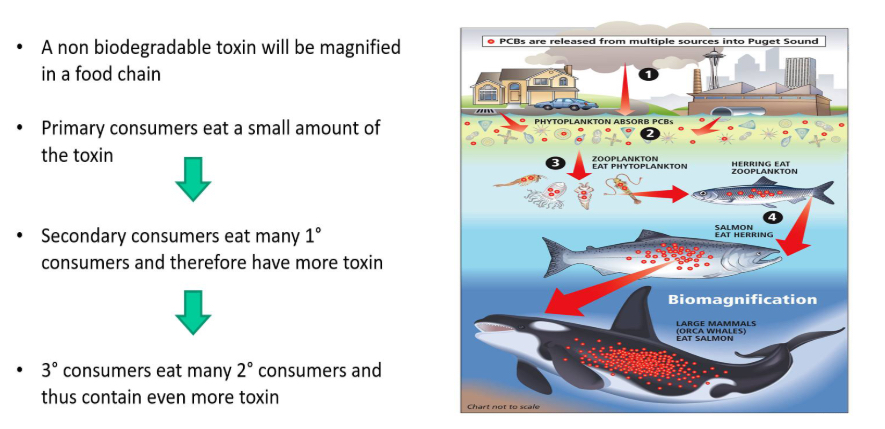2.2: Energy and Biomass in Ecosystems
1/22
There's no tags or description
Looks like no tags are added yet.
Name | Mastery | Learn | Test | Matching | Spaced |
|---|
No study sessions yet.
23 Terms
First law of thermodynamics
Energy cannot be created or destroyed
what is photosynthesis
photosynthesis is the biological process by which energy from the sun is transformed into chemical energy in the form of sugar molecules
Carbon dioxide + water → glucose oxygen
These sugar molecules form the foundations of biomass in most ecological systems
The energy captured by plants via phtotsyntheisis is transformed to the organisms that eat the plants on higher trophic levels, oxygen is a very important product of photosynthesis and provides an essential ecosystem service
Photosynthesis as a system
The chemical reaction of photosynthesis can be approached as a system , with inputs and outputs
Inputs : sunlight as the energy source, carbon dioxide and water
Outputs : glucose and oxygen
Transformation : light energy → chemical energy
Respiration
Cellular respiration is the process whereby chemical energy captured in phtotsynthesis is released within cells of plants and animals
Glucose (a sugar molecule) reacts with oxygen to produce carbon dioxide, water and chemical energy
The reaction of respiration produces a lot of energy in the form of heat which is dissipitated from the organism thus maintaining the relatively low entropy of the organism but increasing the entropy in the whole system
Respiration as a system
Inputs : glucose and oxygen
Outputs : release of energy for ‘work’ and heat , carbon dioxide and water
Transformations : chemical energy (stored) → kinetic energy heat
Energy flow within basic food chains.
Food chains model how energy flows through ecosystems, they typically have 3-5 levels starting with producers (plants) and ending up with top predators
Each level gets less energy than the one before due to energy loss during processes like eating and moving
Arrows in food chains show the direction of energy flow not were it came from
Organisms and levels within the basic food chains
Producers (level 1) make their own food using sunlight (photosynthesis) or chemicals (chemosynthesis) - example plants, algae and some bacteria
Consumers (levels 2+) eat other organisms
Herbivores (levels 2+) eat plants - example deer, rabbits, birds
Carnivores ( higher levels) - eat other animals - example foxes, snakes, owls
Omnivores (higher levels) eat both plants and animals - humans, raccoons and bears
Detrituvivores and decomposers, break down dead organisms and wastes, detritivores eat large pieces eg vultures, whole decomposers eg bacteria break them down further.
Feeding strategy graph

Definition of gross productivity and net productivity
Gross productivity (GP) is the total gain in biomass by an organism.
Net productivity (NP) is the maximum sustainable yield that can be harvested without diminishing the availability for the future
Energy within food webs
In food chains and webs, arrows depict the unidirectional transfer of energy and biomass. They point from the food source (consumed organism) to the consumer (organism doing the eating).
Energy: Captured sunlight by producers flows through consumers, with a portion lost as heat at each level due to cellular respiration.
Biomass: Organic matter (mass of living organisms) is transferred as consumers eat.
Food webs acknowledge the complexity of ecosystems, where:
Species can have diverse diets, feeding at multiple trophic levels. (e.g., an omnivore like a fox might eat both plants and rabbits)
There are interconnected feeding relationships, creating a web-like structure instead of a linear chain.
This highlights the dynamic energy flow within ecosystems, where multiple consumers may interact with various food sources.

What do the arrows in food chains mean
Arrows in food chains and food webs indicate the direction of energy flow and transfer of biomass. In a food web, species may feed at more than one trophic level.
What is biomass
To determine the amount of organic matter (biomass) in a sample, it is often useful to measure its dry mass. This is because water, which is the main component of inorganic matter in most organisms, can be removed from the sample through drying. Thus, the dry mass of the sample can be approximately equal to its biomass.
Furthermore, the energy contained within the biomass can be measured by combusting the samples and extrapolating the results. This process involves burning the sample in a controlled environment and measuring the heat released. By knowing the mass of the sample and the amount of heat released during combustion, the energy content of the sample can be calculated.
What are pyramids of productivity
Pyramids of productivity represent the rate of flow of energy through each trophic level of an ecosystem during a fixed time period (usually 1 year, to account for seasonal effects).
Pyramids of biomass simply represent the momentary stock, whereas pyramids of productivity show the rate at which that stock is being generated.
The values can be expressed as biomass (gm-2yr-1) or as energy, e.g. as kilojoules per square metre per year (kJ m-2yr-1).
Pyramids of productivity are never inverted when one entire year is considered. The solar input of energy may be included as an extra rectangle at the base.
Although there is variation in the literature, for this syllabus “pyramids of biomass” refers to a standing crop (a fixed point in time) and “pyramids of productivity” refer to the rate of flow of biomass or energy.
What is bioaccumulation
Non-biodegradable toxins can accumulate in the tissues of organisms.
When this happens over the lifespan of one organism it is called bioaccumulation
Normally the toxins are fat soluble and build up in fatty tissue
What is biomagnification
Explain are ddt and microplastics

Human impact on flows of energy and and transfer of matter within burning of fossil feuls
Increased CO2: Burning fossil fuels releases carbon dioxide (CO2) into the atmosphere. While CO2 is a greenhouse gas, it's also a raw material for photosynthesis in plants. In theory, increased CO2could potentially lead to increased primary productivity (plant growth). Each year, human activities release more carbon dioxide into the atmosphere than natural processes can remove, causing the amount of carbon dioxide in the atmosphere to increase. The global average carbon dioxide set a new record high in 2022: 417.06 parts per million.
Human impacts on flows of energy and transfers of matter within deforestation, urbanisation and agriculture
Loss of Biomass: These activities all contribute to the loss of trees and other vegetation. This reduces the overall biomass (total amount of living organic matter) within the ecosystem.
Food Web Disruption: Loss of vegetation disrupts food webs as herbivores lose their food source, impacting predator populations that rely on them.
Reduced Photosynthesis: Fewer plants mean less overall photosynthetic activity, leading to a decrease in primary productivity and the amount of energy entering the ecosystem.
Overall impact on human impact on flows of energy and transfers of matters
Human activities like those mentioned disrupt the natural balance within ecosystems. While there may be some initial short-term benefits, the long-term consequences are often detrimental.
Reduced Ecosystem Services: Healthy ecosystems provide us with essential services like clean air and water, food production, and climate regulation. The disruptions caused by human activities jeopardise these services.
Loss of Biodiversity: Reduced plant growth and habitat loss can lead to declines in animal populations and biodiversity loss.
Cascading Effects: The disruption of energy flow and matter transfer in one part of the ecosystem can have cascading effects throughout the entire system, impacting all trophic levels (feeding levels).
What are autotrophs
Autotrophs are organisms that can produce their own food using energy from sunlight or inorganic chemicals. They are also known as producers. Examples of autotrophs include plants, algae, and some bacteria.
Autotrophs carry out photosynthesis or chemosynthesis to convert energy into food. Photosynthesis uses light energy to convert carbon dioxide and water into glucose, which is then used to produce energy and other organic compounds. Chemosynthesis uses energy from inorganic compounds, such as hydrogen sulphide or iron sulphide, to produce organic compounds.
What are heterotrophs
Heterotrophs are organisms that cannot produce their own food and must obtain energy and nutrients from other organisms. They are also known as consumers. Examples of heterotrophs include animals, fungi, and some bacteria.
Heterotrophs obtain food by ingesting other organisms or their organic remains. They break down the organic molecules in their food to obtain energy and nutrients.
Here is a table summarising the key differences between autotrophs and heterotrophs:
What are photoautotrophs
Photoautotrophs utilise light energy as their driving force for photosynthesis. They capture the sun's energy and convert it into chemical energy through a series of reactions into glucose, the primary energy source for most organisms.
What are chemoautotrophs
Chemoautotrophs, on the other hand, derive their energy from exothermic inorganic chemical reactions. They extract energy from the breakdown of inorganic compounds like hydrogen sulphide (H2S), ammonia (NH3), or ferrous iron (Fe2+) to produce organic molecules. This process is called chemosynthesis, and it occurs in the absence of light or other external energy sources.